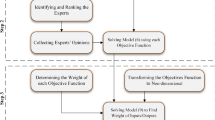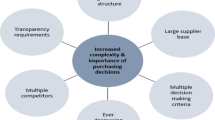Abstract
In the last three decades, companies have intensified their global business activities with suppliers and thereby were able to focus on their core competencies. Today, supplier development in low cost countries is of increasing strategic importance due to its high cost-cutting potential; however, especially low cost country sourcing features high decision complexity and challenges due to changing corporate environment. This paper presents a three step approach to include uncertainty and flexibility into the decision making process on supplier development, using real options valuation. First, the procurement object is analysed followed by an analysis of the corporate environment in which dynamic environmental factors and risks are evaluated. In the final step, the real options value of the supplier development project is determined, including market risks and flexibility of action. The methodology of real options valuation is a useful tool for supplier evaluation in a low cost country environment since it provides a gradual increase in prediction quality through a project-accompanying evaluation and therefore allows for more reliable planning.











Similar content being viewed by others
References
Stolz R, Berking J (2013) Massive changes in the automotive value-chain structure. Oliver Wyman Automotive Manager 1:7–11
Roland Berger Strategy Consultants (2011) Purchasing excellence study: purchasing trends and benchmarks 2011 – Production and non-prod.-related materials/services, Munich
Abele E (2008) Global production—a handbook for strategy and implementation. Springer, Berlin
Sarkis J, Talluri S (2002) A model for strategic supplier selection. J Supply Chain Manag 38(1):18–28
Kumar M, Vrat P, Shankar R (2006) A fuzzy programming approach for vendor selection problem in a supply chain. Int J Prod Econ 101(2):273–285
Costantino N, Pellegrino R (2010) Choosing between single and multiple sourcing based on supplier default risk: a real options approach. J Purch Supply Manag 16(1):27–40
Nembhard HB, Shi L, Aktan M (2003) A real options design for product outsourcing. Eng Econ 48(3):199–217
Hull JC (2006) Options, futures, and other derivatives, 6th edn. Pearson, Upper Saddle River, NJ
PricewaterhouseCoopers, Bundesverband für Materialwirtschaft, Einkauf und Logistik e.V (2008) Beschaffungslogistik im China-Geschäft: Kosten, Prozesse, Strategien. Frankfurt am Main, pp 1–57
Fleischer J, Wawerla M, Schlipf M, Vodicka M (2006) Risk assessment of low-cost suppliers. 22nd industrial marketing and purchasing conference (IMP), Milan
Lanza G, Weiler S, Stoehr A (2009) Valuation of the development of low-cost country suppliers. Proceedings of the 42nd CIRP conference on manufacturing systems: sustainable development of manufacturing systems. 3–5 June 2009, Grenoble (France), pp 48–56
Lanza G, Weiler S (2009) Selection of procurement objects for low-cost country sourcing offering an optimum potential in terms of quality and outcome. Proceedings of the 18th annual IPSERA conference, Oestrich-Winkel, Germany, pp 1229–1245
Lanza G, Weiler S (2008) Conception of a methodology for a comprehensive procurement market selection for low-cost country sourcing. Proceedings of the 13th annual Cambridge international manufacturing symposium, pp 1–23
Lanza G, Weiler S, Vogt S (2010) Design for low-cost country sourcing: defining the interface between product design and production. CIRP J Manuf Sci Technol 2(4):261–271
Govindan K, Khodaverdi R, Jafarian A (2013) A fuzzy multi criteria approach for measuring sustainability performance of a supplier based on triple bottom line approach. J Clean Prod 47:345–354
Nyhuis P, Nickel R, Tullius K (2008) Globales Varianten Produktionssystem—Globalisierung mit System. PZH Produktionstechnisches Zentrum GmbH, Garbsen
Weiler S, Páez D, Chun J-H, Graves SC, Lanza G (2011) Supply chain design for the global expansion of manufacturing capacity in emerging markets. CIRP J Manuf Sci Technol 4(3):265–280
Weiler S (2010) Strategien zur wirtschaftlichen Gestaltung der globalen Beschaffung. Shaker, Aachen
Luenberger DG (2013) Investment science, 2nd edn. Oxford University Press, New York
Brockwell PJ, Davis RA (2010) Introduction to time series and forecasting, 2nd edn. Springer, New York
London Metal Exchange (2013) Historical data. http://www.lme.co.uk/historical_data.asp. Accessed 7 June 2013
Organisation for Economic Co-operation and Development (OECD) (2013) Statistics portal. http://stats.oecd.org/#. Accessed 7 June 2013
DESTATIS Statistisches Bundesamt Deutschland (2013) Erzeugerpreisindex Luftfracht—Korea. www.destatis.de. Accessed 7 June 2013
Oanda.com (2013) Historical currency exchange rates. http://www.oanda.com/convert/fxhistory. Accessed 7 June 2013
Mertens P (ed) (2012) Prognoserechnung, 7th edn. Physica, Heidelberg
Schulmerich M (2010) Real options valuation: the importance of interest rate modelling in theory and practice. Springer, Berlin
Borison A (2005) Real option analysis: where are the emperor’s clothes? J Appl Corp Financ 17(2):17–32
Copeland TE, Antikarov V (2009) Real options: a practitioner’s guide. Cengage Learning, New York
Godinho P (2006) Monte Carlo estimation of project volatility for real options analysis. J Appl Financ 16(1):15–30
Acknowledgments
We extend our sincere thanks to the Deutsche Forschungsgemeinschaft (German Research Foundation) for supporting this research Project LA2351/11-1 “Wirtschaftliche Gestaltung eines Lieferantenaufbaus” (“Economical Designing of Supplier Qualification”).
Author information
Authors and Affiliations
Corresponding author
Rights and permissions
About this article
Cite this article
Ruhrmann, S., Hochdörffer, J. & Lanza, G. A methodological approach to evaluate supplier development based on real options. Prod. Eng. Res. Devel. 8, 373–382 (2014). https://doi.org/10.1007/s11740-014-0529-z
Received:
Accepted:
Published:
Issue Date:
DOI: https://doi.org/10.1007/s11740-014-0529-z




